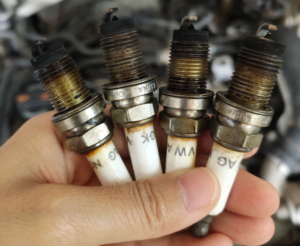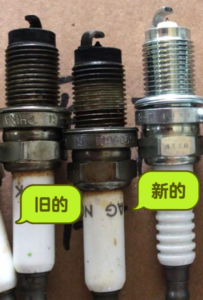Muitos entusiastas de automóveis podem ter dúvidas: as velas de ignição devem ser substituídas durante a manutenção? Com que frequência eu mudo o velas de ignição?
O proprietário de um carro relatou um problema de reparo: potência insuficiente durante a condução, vibração ociosa severa, e alto consumo de combustível.

Como mostrado na imagem: Volkswagen Sagitar usa um 60000 vela de ignição quilométrica, que fica preto e os contatos já foram queimados. Combustão deficiente leva a energia insuficiente, falta de resposta do cilindro, uma série de solavancos durante a condução, e alto consumo de combustível.
Como nossas peças de carro, a maioria deles usa linhas de vida, como velas de ignição. Materiais e marcas diferentes têm diferentes ciclos de vida.
1. Plugues de ignição da liga de níquel 20000 para 30000 quilômetros
2. 40000 quilômetros de linha de ignição de platina única
3. Velas de ignição de platina dupla 60000 quilômetros
4. Iridium plugues de ignição, 80000 quilômetros, etc.
A vida útil dessas velas de ignição é recomendada apenas pelo fabricante de peças. Na verdade, O modelo de veículo e os hábitos de direção terão um impacto na vida útil das velas de ignição, Portanto, é julgado que se as velas de ignição não forem substituídas.
Pessoalmente, Recomenda -se desmontar e inspecionar as velas de ignição a cada 3 anos ou 60000 quilômetros para determinar se os substituímos com base em sua cor e espaçamento de contato.
4As lojas S também têm algumas garagens de reparo que as substituem de acordo com o manual de manutenção, que economiza tempo, Mas não é fácil ganhar dinheiro. É melhor verificar e ver a condição específica da qualidade antes de tomar uma decisão.

Pode haver muitos entusiastas de carros que vêem isso, Mas quais são as consequências de não substituir as velas de ignição?
1. Energia insuficiente e agitação ociosa: Uma diminuição no desempenho da vela de ignição causará uma diminuição linear no desempenho da ignição do motor, resultando em aceleração fraca, energia insuficiente, e tremendo durante a aceleração.
2. Maior consumo de combustível: A ignição anormal pode causar combustão insuficiente da mistura, Reduza a eficiência da conversão, e requer mais gás para combustão, acelerando o consumo de combustível.
3. Em casos graves, Há também uma falta de trabalho de cilindro, resultando em uma série de idiotas desconfortáveis.


